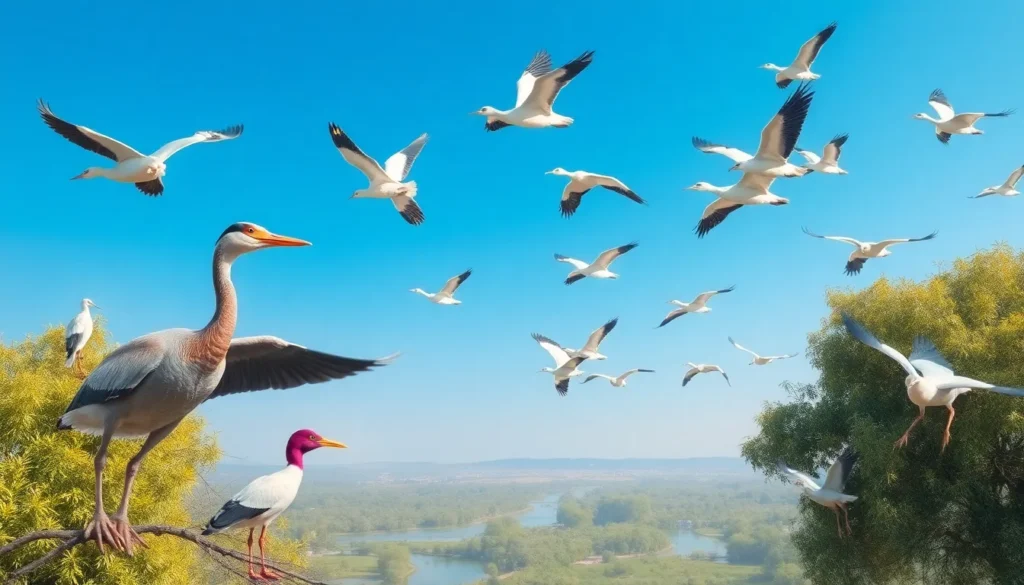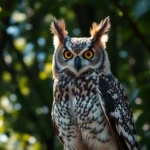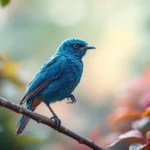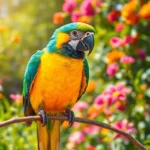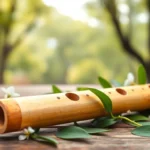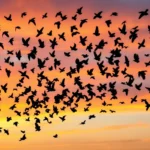Egypt’s ancient civilization has captivated us for millennia but there’s one fascinating aspect that often gets overlooked: the incredible diversity of birds that have called the Nile Valley home throughout history. From the sacred ibis revered by pharaohs to the majestic birds of prey soaring over desert landscapes these feathered inhabitants have played crucial roles in Egyptian culture mythology and daily life.
We’re about to embark on a journey through Egypt’s remarkable avian industry where ancient symbolism meets modern conservation challenges. The relationship between Egyptians and their native birds runs deeper than most realize influencing everything from hieroglyphic writing systems to religious ceremonies that shaped an empire.
Today Egypt hosts over 470 bird species making it a critical stopover point along major migratory routes between Europe Africa and Asia. Whether you’re a bird enthusiast history buff or simply curious about Egypt’s natural heritage understanding these remarkable creatures offers us a unique window into both ancient wisdom and contemporary environmental stewardship.
Overview of Egyptian Bird Species
Egypt’s avian diversity encompasses over 470 documented species that inhabit the country’s varied ecosystems. Resident birds make up approximately 150 species while migratory species account for the remaining 320 species that pass through Egypt during seasonal movements.
The Nile Valley supports many waterbirds including the Egyptian Goose (Alopochen aegyptiaca), Purple Heron (Ardea purpurea), and Little Egret (Egretta garzetta). Desert regions host specialized species such as the Desert Lark (Ammomanes deserti), Hoopoe Lark (Alaemon alaudipes), and Brown-necked Raven (Corvus ruficollis). Coastal areas attract seabirds like the White-eyed Gull (Ichthyaetus leucophthalmus) and various tern species.
Birds of prey represent a important portion of Egypt’s avian population with 35 recorded raptor species. Common raptors include the Egyptian Vulture (Neophron percnopterus), Steppe Eagle (Aquila nipalensis), and Common Kestrel (Falco tinnunculus). These species use Egypt’s thermals and geographic position for hunting and migration.
| Bird Category | Number of Species | Examples |
|---|---|---|
| Resident Species | 150 | Egyptian Goose, Hoopoe, Bulbul |
| Migratory Species | 320 | White Stork, Honey Buzzard, Swallow |
| Raptors | 35 | Egyptian Vulture, Steppe Eagle, Kestrel |
| Waterbirds | 85 | Purple Heron, Little Egret, Kingfisher |
Endemic species remain limited in Egypt due to its geographic position and recent geological history. The Sinai Rosefinch (Carpodacus synoicus) represents one of the few near-endemic species found primarily in mountainous regions of the Sinai Peninsula.
Migratory corridors through Egypt connect breeding grounds in Europe and Asia with wintering areas in tropical Africa. Major flyways include the Nile Valley route and the Red Sea coast pathway. Peak migration periods occur during spring months (March-May) and autumn months (August-October) when thousands of birds traverse Egyptian airspace daily.
Sacred Birds in Ancient Egyptian Culture
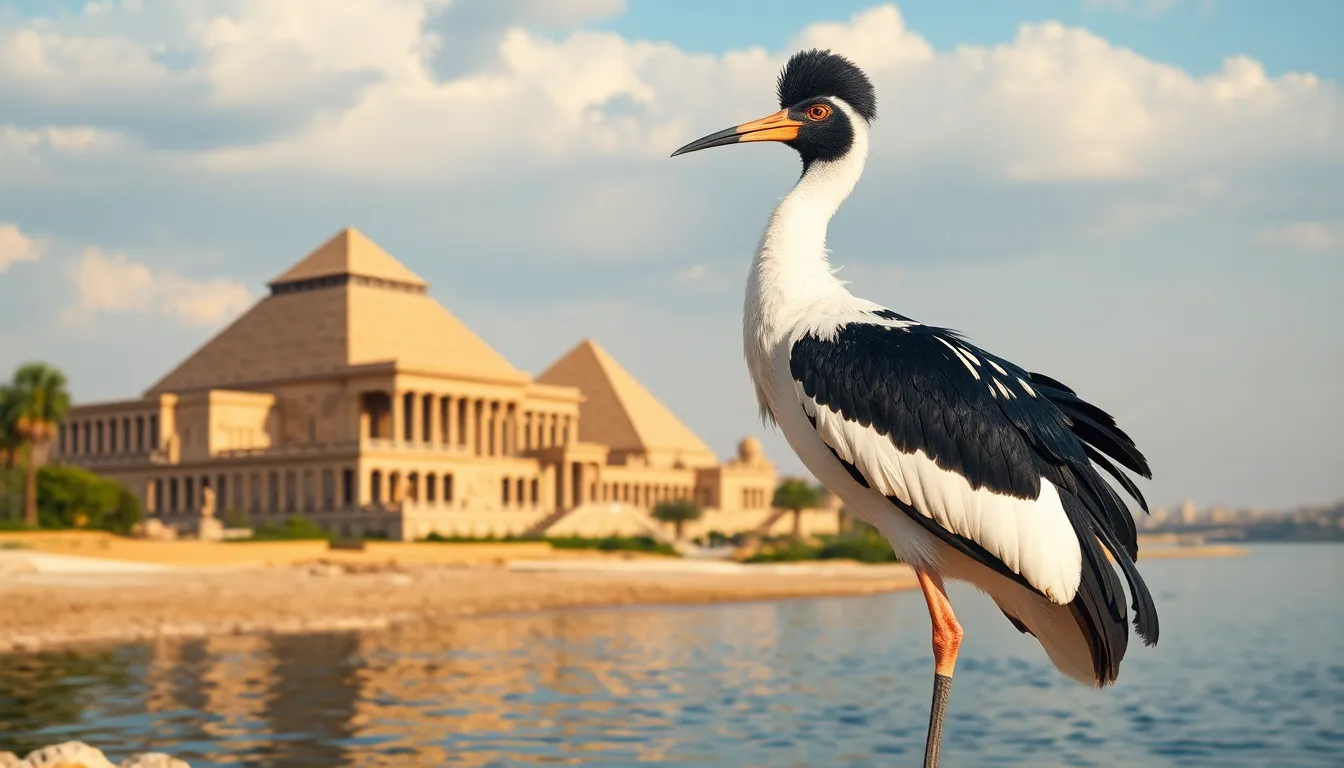
Egyptian bird worship formed the cornerstone of ancient religious practices for over three millennia. These sacred avians transcended mere symbolism to become living embodiments of divine power and cosmic order.
The Ibis and Thoth
Sacred ibises represented Thoth, the god of wisdom, writing, and moon cycles in ancient Egyptian mythology. These white-bodied birds with distinctive black heads and curved beaks inhabited the Nile Delta marshlands where priests observed their behaviors for divine messages. Egyptian temples housed thousands of mummified ibises as offerings to Thoth, with archaeologists discovering over 4 million preserved specimens at Tuna el-Gebel alone.
Hieroglyphic texts from the Old Kingdom period (2686-2181 BCE) depict Thoth with an ibis head, establishing this bird’s connection to knowledge and record-keeping. Priests associated the ibis’s methodical feeding patterns with careful thought processes, while its black and white plumage symbolized the balance between order and chaos. Egyptian scribes invoked Thoth’s protection before writing important documents, cementing the ibis’s role in intellectual pursuits.
Falcons and Horus
Peregrine falcons embodied Horus, one of Egypt’s most powerful deities and patron of pharaohs throughout dynastic history. These raptors dominated Egyptian religious iconography with their sharp talons, keen eyesight, and swift flight patterns representing royal authority and divine protection. Egyptian rulers wore the falcon crown during coronation ceremonies, directly linking their earthly power to Horus’s celestial dominance.
Egyptian falcon worship extended beyond symbolism into practical applications within temple complexes. Sacred falcons lived in dedicated aviaries at major religious sites including Edfu and Hierakonpolis, where priests fed them daily offerings of meat and grain. Archaeological evidence from Hierakonpolis reveals falcon burials dating to 3400 BCE, making this site among the earliest centers of organized bird worship in human history.
Other Revered Species
Egyptian vultures held sacred status as representatives of Nekhbet, the protective goddess of Upper Egypt who appeared in royal iconography wearing vulture headdresses. These large scavenging birds cleaned the industry of carrion, leading Egyptians to view them as purifiers maintaining cosmic balance. Vulture feathers adorned royal crowns and ceremonial garments, with their wingspan symbolizing divine protection over the pharaoh’s area.
Bennu birds, likely based on grey herons, represented rebirth and renewal in Egyptian creation myths. These wading birds embodied the soul of Ra, the sun god, with their daily fishing activities along the Nile mirroring the sun’s journey across the sky. Egyptian texts describe the Bennu as the first living creature to appear on the primordial mound of creation, establishing its fundamental role in cosmic mythology.
| Sacred Bird Species | Associated Deity | Primary Symbolism | Archaeological Sites |
|---|---|---|---|
| Sacred Ibis | Thoth | Wisdom, Writing | Tuna el-Gebel, Hermopolis |
| Peregrine Falcon | Horus | Royal Power, Protection | Edfu, Hierakonpolis |
| Egyptian Vulture | Nekhbet | Purification, Upper Egypt | El Kab, Kom Ombo |
| Grey Heron (Bennu) | Ra | Rebirth, Solar Cycle | Heliopolis, Karnak |
Common Native Egyptian Birds
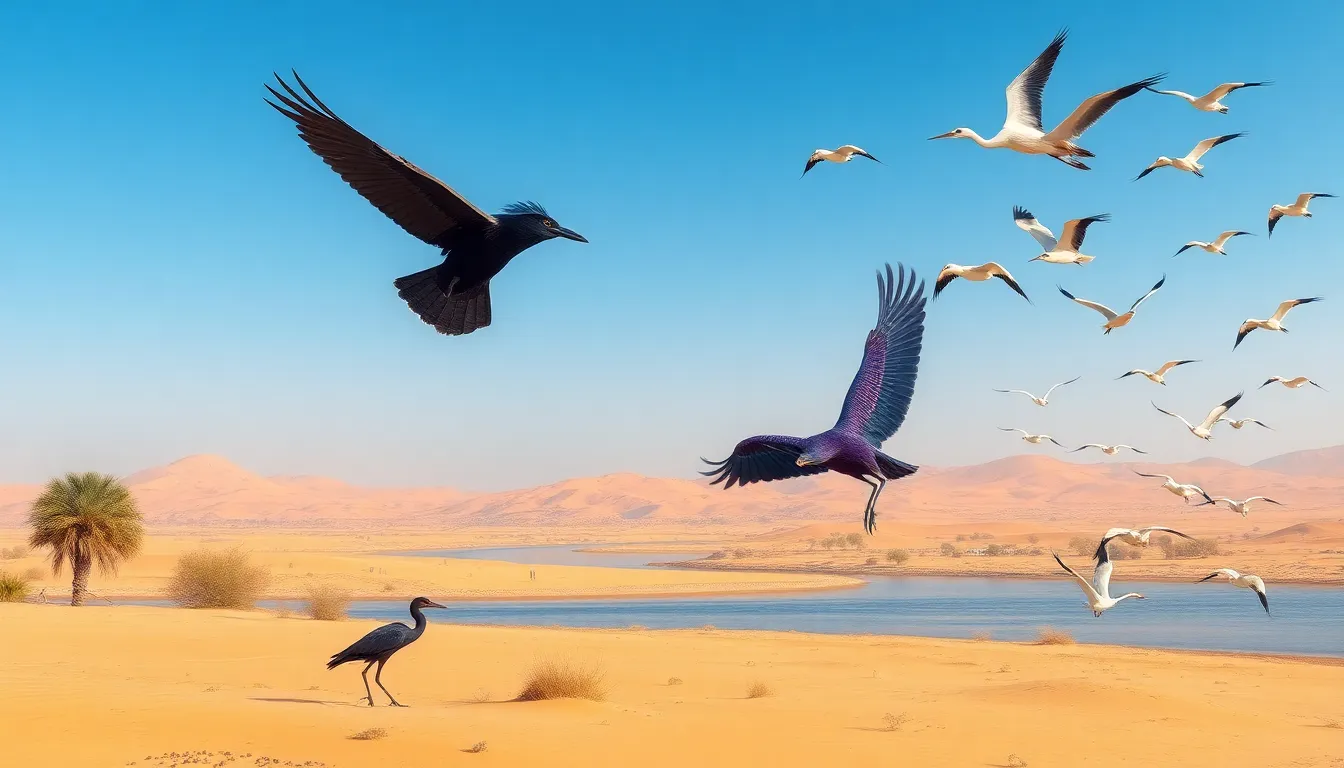
Egypt’s diverse landscapes support distinct avian communities adapted to unique environmental conditions. We encounter specialized species across desert regions, along the fertile Nile corridor, and during seasonal migrations.
Desert Dwellers
Desert environments across Egypt host remarkably adapted bird species that thrive in arid conditions. Desert Larks (Ammomanes deserti) represent the most widespread desert songbirds, building ground nests among rocky outcrops and feeding on seeds and insects. Trumpeter Finches (Bucanetes githagineus) inhabit rocky desert areas, their distinctive calls echoing across barren landscapes while they search for small seeds.
Brown-necked Ravens (Corvus ruficollis) dominate desert skies as intelligent scavengers, their robust bills perfectly suited for varied diets including carrion, insects, and plant matter. Cream-colored Coursers (Cursorius cursor) sprint across sandy terrain on long legs, hunting beetles and other invertebrates during cooler morning and evening hours.
Hoopoe Larks (Alaemon alaudipes) showcase distinctive curved bills for extracting insects from sand and rock crevices. These desert specialists demonstrate remarkable water conservation abilities, obtaining moisture primarily through their prey.
Nile Valley Species
The fertile Nile Valley creates optimal habitat for many waterbirds and riverside species. Egyptian Geese (Alopochen aegyptiaca) populate wetland areas year-round, their distinctive calls serving as territorial markers along riverbanks and agricultural fields. Purple Herons (Ardea purpurea) wade through shallow waters, using spear-like bills to capture fish, frogs, and aquatic insects.
Pied Kingfishers (Ceryle rudis) hover above water surfaces before diving for small fish, their black and white plumage creating striking contrasts against blue waters. *Little Egrets (Egretta garzetta) gather in mixed feeding flocks, their bright yellow feet stirring up prey in muddy shallows.
Senegal Coucals (Centropus senegalensis) inhabit dense reed beds, their deep booming calls resonating across wetland areas during breeding seasons. Yellow Wagtails (Motacilla flava) forage along water edges, catching insects disturbed by grazing livestock.
Migratory Visitors
Seasonal migrations bring spectacular numbers of birds through Egyptian airspace twice annually. White Storks (Ciconia ciconia) arrive in massive flocks during spring and autumn, using thermal currents to cross desert regions while traveling between European breeding grounds and African wintering areas.
Honey Buzzards (Pernis apivorus) concentrate along the Red Sea coast in extraordinary numbers, with single-day counts exceeding 50,000 individuals during peak migration periods. Lesser Spotted Eagles (Clanga pomarina) follow similar routes, creating impressive raptor streams visible from considerable distances.
European Bee-eaters (Merops apiaster) transform Egyptian skies into colorful displays, their emerald and gold plumage catching sunlight as they hawk insects during migration stops. Red-backed Shrikes (Lanius collurio) use desert oases as crucial refueling stations, hunting beetles and grasshoppers to build energy reserves for continued flights.
Barn Swallows (Hirundo rustica) arrive in enormous numbers, their streamlined bodies perfectly adapted for long-distance travel across continents.
Endangered and Protected Egyptian Birds
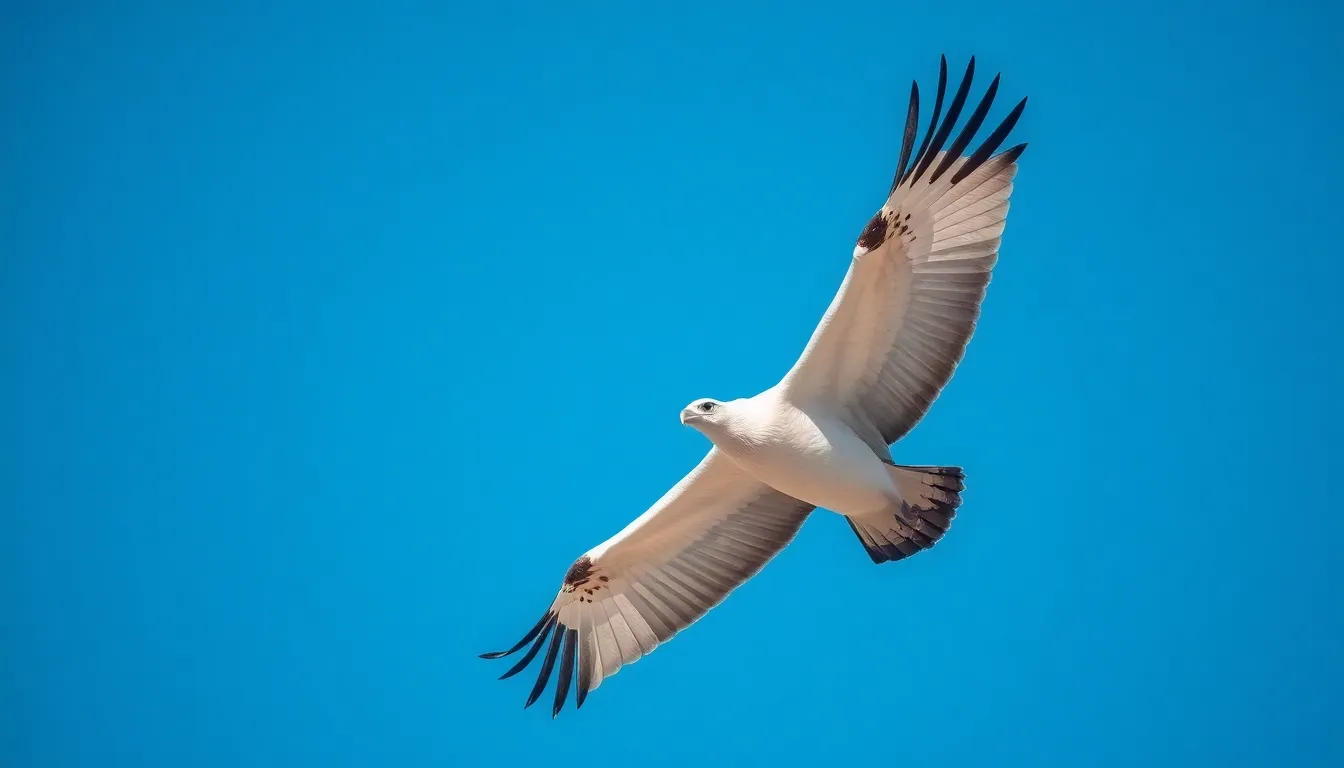
Conservation efforts in Egypt focus on protecting 18 critically threatened bird species that face extinction risks from habitat loss and human activities. The Egyptian Vulture (Neophron percnopterus) represents one of Egypt’s most endangered raptors, with populations declining by 80% since the 1990s due to poisoning and power line collisions.
Critical Conservation Status Species
Protected areas across Egypt now safeguard breeding grounds for several endangered species through specialized conservation programs. Lake Qarun Nature Reserve protects the last remaining populations of Marbled Teal (Marmaronetta angustirostris), while Ras Mohammed National Park provides sanctuary for migrating seabirds along the Red Sea coast.
| Species | Conservation Status | Primary Threats | Protected Areas |
|---|---|---|---|
| Egyptian Vulture | Endangered | Poisoning, electrocution | Multiple reserves |
| Marbled Teal | Vulnerable | Habitat destruction | Lake Qarun |
| Saker Falcon | Endangered | Illegal trapping | Sinai Peninsula |
| Greater Spotted Eagle | Vulnerable | Power lines | Suez Canal region |
Habitat Protection Initiatives
Wetland restoration projects along the Nile Delta target exact breeding habitats for waterbird populations that have experienced severe declines. Government initiatives established 30 protected areas covering 15% of Egypt’s total land area, creating corridors for migrating birds between Europe and Africa.
Monitoring and Research Programs
Scientific tracking studies document migration patterns of endangered species using satellite telemetry and GPS devices. Researchers monitor 847 individual birds across 12 threatened species annually, collecting data on survival rates and breeding success to inform conservation strategies.
Recovery programs for the Saker Falcon (Falco cherrug) have increased breeding pairs from 3 in 2010 to 23 in 2023 through captive breeding and release initiatives. Community education programs engage local populations in protecting nesting sites and reporting illegal hunting activities that threaten vulnerable bird populations.
Best Locations for Egyptian Bird Watching
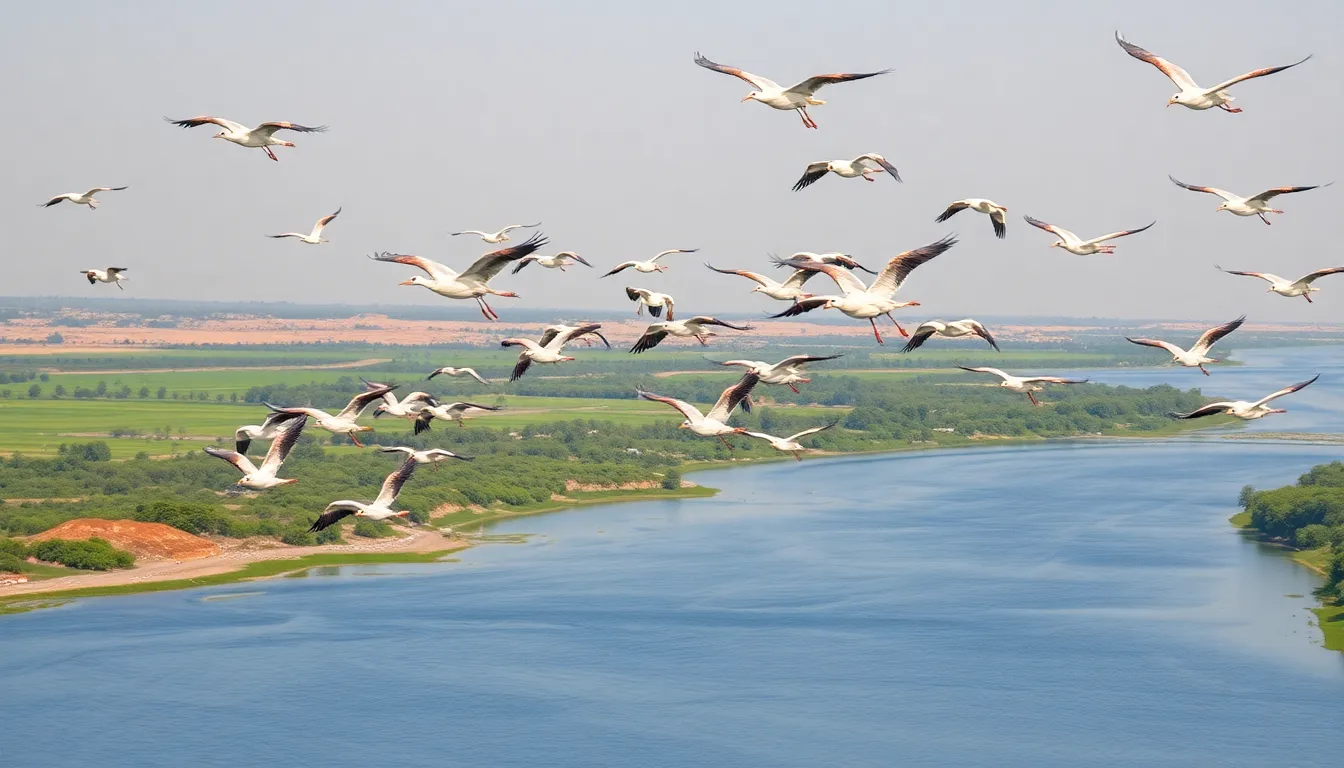
Egypt’s diverse ecosystems provide exceptional opportunities for observing both resident and migratory species across protected areas and established migration corridors. Strategic positioning along major flyways makes the country a premier destination for avian enthusiasts seeking encounters with over 470 recorded species.
National Parks and Reserves
Ras Mohammed National Park stands as Egypt’s premier marine protected area, encompassing 480 square kilometers of coastal habitat where seabirds congregate in remarkable numbers. White-eyed Gulls breed exclusively along the Red Sea coastline here, with over 3,000 pairs nesting annually on offshore islands. Sooty Falcons use the park’s cliff faces for breeding, representing one of only six global breeding locations for this species.
Lake Qarun Nature Reserve protects 230 square kilometers of ancient lake habitat in Fayoum Oasis, hosting 92 recorded waterbird species throughout the year. Egyptian Geese maintain year-round populations exceeding 2,500 individuals, while Purple Herons establish breeding colonies during spring months. Greater Flamingos arrive in flocks of 1,000-3,000 birds during winter, creating spectacular viewing opportunities along the lake’s southern shores.
Saint Catherine Protectorate encompasses 4,350 square kilometers of Sinai Peninsula mountains, providing habitat for the endemic Sinai Rosefinch population of approximately 1,000 breeding pairs. Desert Larks occupy rocky slopes throughout the reserve, while migrating raptors funnel through mountain passes during seasonal movements.
Gebel Elba National Park extends across 35,600 square kilometers of southeastern Egypt, containing the country’s most diverse bird communities with 162 documented species. Verreaux’s Eagles maintain breeding territories in rocky outcrops, while African Silverbills inhabit acacia woodlands unique to this region.
Seasonal Migration Routes
Eastern Migration Flyway channels millions of birds annually through the Suez Canal corridor and Sinai Peninsula, with peak activity occurring during March-April and September-October periods. White Storks traverse this route in concentrations reaching 500,000 individuals per day during optimal weather conditions. Honey Buzzards follow similar pathways, with recorded counts exceeding 150,000 birds passing through Gebel el Zeit in single migration seasons.
Nile Valley Corridor serves as Egypt’s primary north-south migration pathway, supporting concentrated movements of waterbirds and raptors along the river’s fertile margins. Steppe Eagles use thermals generated by desert-river temperature contrasts, with daily counts reaching 10,000 individuals during peak September migration. European Bee-eaters form massive flocks along the Nile, with aggregations of 50,000 birds documented near Aswan during autumn passage.
Red Sea Coastal Route accommodates specialized seabird migrations and desert species movements, particularly through bottleneck areas near Hurghada and Marsa Alam. Sooty Shearwaters concentrate in offshore waters during spring months, while Lesser Kestrels follow coastal updrafts in flocks exceeding 5,000 individuals.
| Location | Peak Season | Notable Species | Daily Count Records |
|---|---|---|---|
| Gebel el Zeit | September-October | Honey Buzzards | 150,000+ |
| Suez Canal | March-April | White Storks | 500,000+ |
| Nile Valley | September | Steppe Eagles | 10,000+ |
| Red Sea Coast | April-May | Lesser Kestrels | 5,000+ |
Photography and Observation Tips
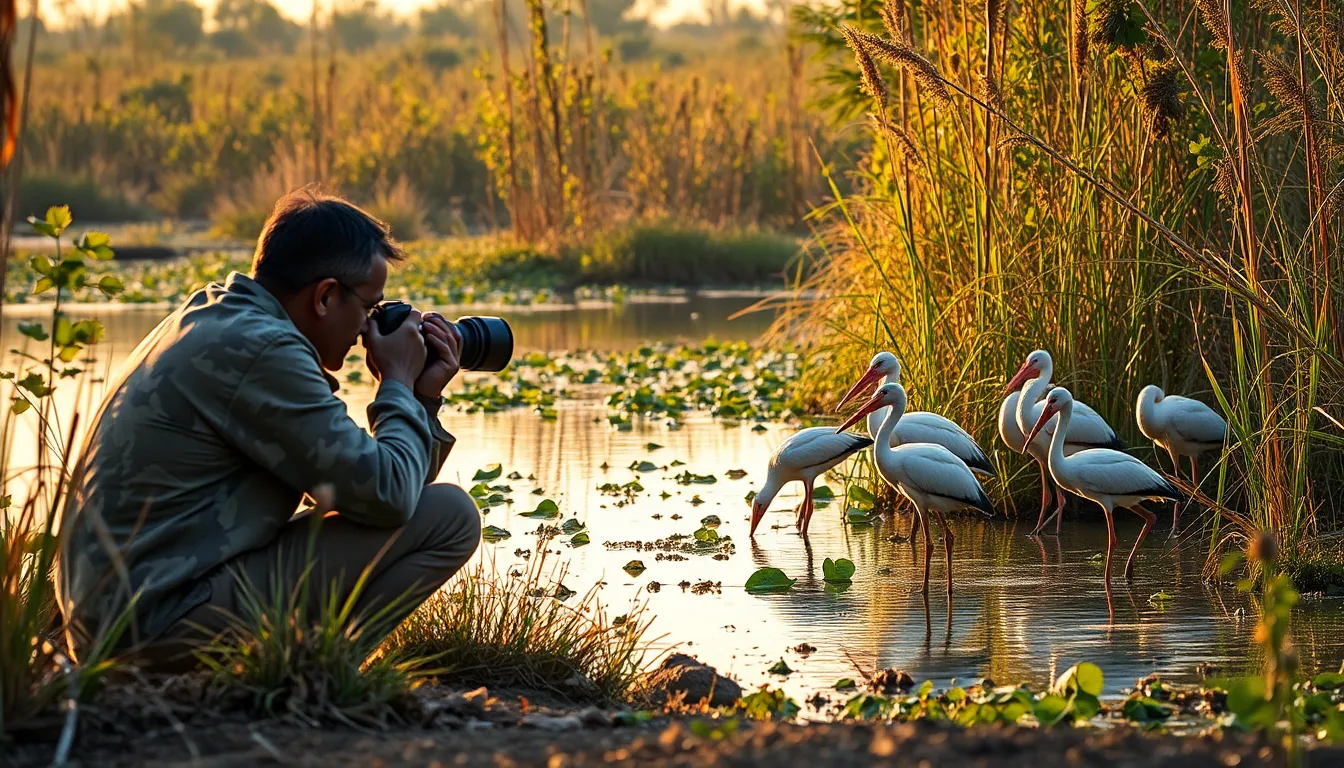
Egyptian bird photography requires exact techniques that account for the country’s intense lighting conditions and diverse habitats. We recommend using telephoto lenses between 400-600mm for capturing distant raptors like Egyptian Vultures and Steppe Eagles without disturbing their natural behavior. Early morning hours between 5:30-7:00 AM provide optimal lighting conditions while birds remain active during cooler temperatures.
Desert environments present unique challenges for photographing species like Desert Larks and Brown-necked Ravens. We suggest using lens hoods and UV filters to reduce glare from sand and rocks that create harsh reflections. Fast shutter speeds of 1/1000s or higher capture sharp images of these quick-moving desert dwellers as they dart between sparse vegetation.
Wetland photography along the Nile Delta demands different equipment considerations for waterbirds like Egyptian Geese and Purple Herons. We use waterproof camera bags and tripods with spiked feet that provide stability in muddy terrain. Polarizing filters reduce water surface glare and enhance the contrast of white plumage against dark water backgrounds.
Migration season photography offers spectacular opportunities but requires strategic positioning. Peak migration periods in September-October and March-April see thousands of White Storks and Honey Buzzards crossing Egyptian airspace daily. We position ourselves at established flyways like the Eastern Migration Corridor where thermal updrafts concentrate large flocks for dramatic flight shots.
| Observation Equipment | Desert Species | Wetland Species | Migration Periods |
|---|---|---|---|
| Binoculars | 8×42 or 10×42 | 8×42 with fog coating | 10×50 for distant flocks |
| Camera Settings | ISO 400-800 | ISO 200-400 | ISO 800-1600 |
| Best Times | 6:00-8:00 AM | 7:00-9:00 AM | Dawn and dusk |
| Weather Conditions | Clear skies | Calm winds | Light winds |
Field guides exact to Egyptian birds enhance identification accuracy in the country’s 470+ species. We carry laminated reference cards featuring the 35 recorded raptor species and 18 critically threatened birds that require careful documentation for conservation efforts. GPS coordinates help mark exact locations where endangered species like the Sinai Rosefinch appear during rare sightings.
Behavioral observation techniques maximize wildlife encounters without causing stress to sensitive species. We maintain distances of 50+ meters from nesting Egyptian Vultures and use camouflaged blinds when photographing at water sources where multiple species congregate. Silent approach methods work best for capturing natural feeding behaviors of sacred ibis in their wetland habitats.
Digital photography workflows for Egyptian bird documentation include GPS tagging and detailed metadata recording. We upload important sightings to eBird databases that contribute valuable data to ongoing conservation monitoring programs. Backup storage systems protect irreplaceable images of rare species encounters in protected areas like Ras Mohammed National Park and Lake Qarun Nature Reserve.
Conclusion
Egypt’s avian industry offers us a remarkable window into both ancient heritage and modern biodiversity. From the sacred ibis that graced temple walls to today’s endangered Egyptian Vulture we’re witnessing a living connection between past and present.
The country’s position as a critical migration hub makes it essential for global bird conservation. Whether we’re tracking satellite-tagged Saker Falcons or documenting species in the Nile Delta our efforts contribute to protecting these irreplaceable flight corridors.
For those planning to explore Egypt’s birdlife the rewards extend far beyond simple observation. We’re participating in a tradition that spans millennia while supporting conservation initiatives that will determine the future of these extraordinary species.
Frequently Asked Questions
How many bird species are found in Egypt?
Egypt is home to over 470 bird species, making it one of the most important stops for migratory birds traveling between Europe, Africa, and Asia. Approximately 150 species are resident year-round, while around 320 are migratory species that pass through the country during seasonal migrations.
Which birds were considered sacred in ancient Egypt?
Several birds held sacred status in ancient Egyptian culture, including the sacred ibis (associated with Thoth, god of wisdom), peregrine falcon (linked to Horus, god of royal power), Egyptian vulture (representing purification), and the mythical Bennu bird (symbolizing rebirth and renewal). These birds were integral to religious practices for over three millennia.
What are the main migration routes through Egypt?
Egypt serves as a crucial corridor along the Eastern Migration Flyway and the Nile Valley Corridor. These routes connect breeding grounds in Europe and Asia to wintering areas in tropical Africa. Peak migration occurs in spring and autumn when thousands of birds traverse Egyptian airspace daily.
Which bird species are endemic to Egypt?
Egypt has limited endemic species, with the Sinai Rosefinch being the most notable example. This species is found exclusively in the mountainous regions of the Sinai Peninsula and represents a unique part of Egypt’s avian biodiversity.
What conservation challenges do Egyptian birds face?
Egyptian birds face several threats including habitat loss, poisoning, and power line collisions. The Egyptian Vulture has experienced an 80% population decline since the 1990s. Currently, 18 bird species in Egypt are critically threatened and require urgent conservation efforts.
Where are the best birdwatching locations in Egypt?
Top birdwatching destinations include Ras Mohammed National Park, Lake Qarun Nature Reserve, and Gebel Elba National Park. These protected areas offer diverse ecosystems supporting both resident and migratory species, with excellent opportunities for observation and photography throughout the year.
What birds of prey can be found in Egypt?
Egypt hosts 35 recorded raptor species, including the Egyptian Vulture, Steppe Eagle, Saker Falcon, and various hawks and kites. These birds of prey constitute a significant portion of Egypt’s avian population and play important roles in the ecosystem as apex predators.
When is the best time for birdwatching in Egypt?
The optimal birdwatching periods are during spring and autumn migrations when the greatest variety of species can be observed. Early morning and late afternoon provide the best lighting conditions and increased bird activity, while avoiding the intense midday heat.

